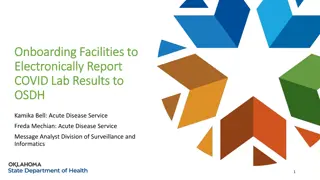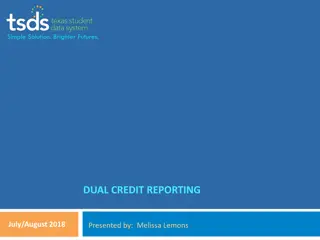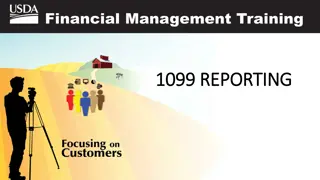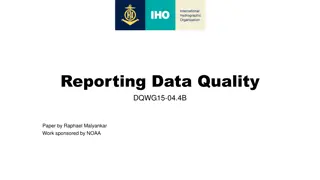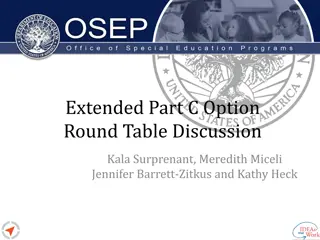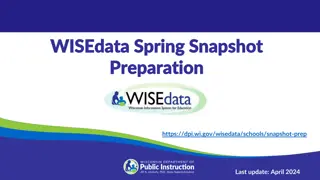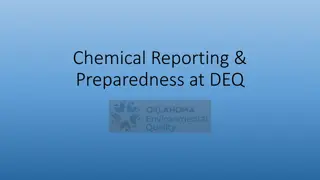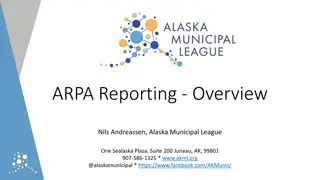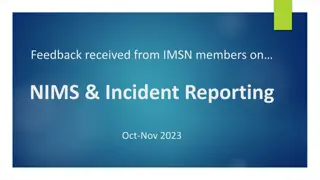FIREX-AQ Data Management Plan and Reporting Guidelines
This data management plan outlines the repositories, submission schedule, format requirements, and reporting guidelines for the FIREX-AQ airborne field study conducted by Gao Chen (NASA Langley Research Center) and Ken Aikin (NOAA Earth System Research Laboratory). It covers access control, data types, submission deadlines, data formats, metadata requirements, and data ID registration for ensuring high-quality and standardized data reporting.
Download Presentation

Please find below an Image/Link to download the presentation.
The content on the website is provided AS IS for your information and personal use only. It may not be sold, licensed, or shared on other websites without obtaining consent from the author.If you encounter any issues during the download, it is possible that the publisher has removed the file from their server.
You are allowed to download the files provided on this website for personal or commercial use, subject to the condition that they are used lawfully. All files are the property of their respective owners.
The content on the website is provided AS IS for your information and personal use only. It may not be sold, licensed, or shared on other websites without obtaining consent from the author.
E N D
Presentation Transcript
Data Management Plan for FIREX-AQ Airborne Field Study Gao Chen NASA Langley Research Center Ken Aikin NOAA Earth System Research Laboratory
FIREX-AQ Data Repositories Current Plan: NOAA Data Repository: esrl.noaa.gov/csd/projects/firex-aq NOAA TwinOtter-CHEM, TwinOtter-MET, and NightFOX NASA Data Repository: www-air.larc.nasa.gov NASA DC-8 and ER-2 Ground mobile labs Trajectories, model results, satellite WE-CAN final data and merges NOAA TwinOtter-CHEM, TwinOtter-MET, and NightFOX Final data Data repositories will have common access control and be cross-linked Username: ............ Password: .. ..
FIREX-AQ Data Submission Schedule Mission Phase Submission Deadline Access Control Data Type Field Deployment 24 hour after each flight or cal. Day Science team and Partners Field Data Post- Deployment Final Data May 2, 2020 Public Field data submission deadline may vary depending on field operation constraints The final data should be of publication quality and time synched to the time standard for each platform
FIREX-AQ Data Format Requirements The data from FIREX-AQ field study will conform to ICARTT, netCDF, or HDF format All in-situ measurements are required to report data in ICARTT format. Detailed format description can be found at: http://www- air.larc.nasa.gov/missions/etc/IcarttDataFormat.htm. All incoming data files from in-situ measurements will be scanned to ensure compliance to the ICARTT format requirements. A common file scanner will be used for both data repository Assistance will be made available to the science team to troubleshoot issues in generating ICARTT files. The remote sensing measurement instruments and models may report data in either HDF, netCDF, or ICARTT format
FIREX-AQ Data Reporting I FIREX-AQ Metadata Requirements: The FIREX-AQ data files should be self-describing through information on: variable definition, unit, data reporting information, measurement description, measurement uncertainty and detection limits The metadata requirements are uniform for all file formats FIREX-AQ requires standardized instrument description DataID Registration: PI will need to register his/her dataID(s) before file submission, which is used to organize files on the data repository and is a part of the FIREX-AQ file naming convention. DataID, prefixed by FIREXAQ, is a typically short description of measured parameter/species, instrument, or model (e.g., FIREXAQ- O3). The website is open for dataID registration; detailed instructions will be distributed.
FIREX-AQ Data Reporting II Use the same number of variables and variable names throughout mission for the files with the same same dataID Measurement Time Reporting: Use fixed variable name(s) for Time Stamps, i.e., Time_Start, Time_Stop, and Time_Mid Use start, stop, and mid times if integration interval larger than 1 sec Use one time stamp (Time_Start or Time_Stop) for data at 1 Hz Data Interval = actual value for constant interval data Data Interval = -1 for irregular interval data Contact Ali or Gao Use Special Comments to indicate if the measurement time is synched to the time standard Indicate trace gas is reported in dry or ambient condition and report absolute concentration and aerosol extensive properties at STP: 273K and 1013 mb Consider to use common attributes for HDF and netCDF file, at least for similar models or instruments Add variable standard names in the variable definition line
Variable Standard Names tags, NOT short names: short name, unit, standard name, long name CH2O_pptv, pptv, Gas_CH2O_insitu_S_AVMR, mixing ratio by volume CH2O_LOD_pptv, pptv, Gas_CH2O_insitu_S_AVMR, Limit of Detection NOy_pptv, pptv, Gas_NOyasNO_insitu_M_AVMR, Total Reactive Nitrogen Mixing Ratio Sc700_total, Mm-1, AER_Scattering_insitu_red_RHd_Total_AMB, Dry Scattering at 700nm (Total Aerosols) Standard Name Structure: MeasMedium_CoreName_MeasMode_DescriptiveAttributes intended to help data discovery and machine readability (i.e., shared vocabulary) divided into 6 categories: Trace Gas, Aerosol, Cloud, Radiation, j Values, Nav and Met complete list will be available on the data website Looking for feedback to improve the current list
FIREX-AQ Data File Naming Convention DataID_LocationID_YYYYMMDD_R#_Description.extension DataID: a short description of measured parameter/species, instrument, or model LocationID: an identifier of measurement platform: e.g. DC8, will be provided on the website in a drop-down box YYYYMMDD: UTC date when the flight take off or the beginning of the measurement for ground sites R#: Revision number. The revision number will be RA, RB, RC, for field data and R0, R1, R2, for the final data. Note: archived files cannot be overwritten Description: optional additional description of the file if necessary Extension: ict for ICARTT files, h4 for HDF 4 files, and h5 for HDF 5 files, etc. Examples: the filename for DC-8 diode laser spectrometer H2O measurement made on May 1, 2016 flight may be: FIREXAQ-DLH-H2O_DC8_20190801_RA.ICT (for field data) FIREXAQ-DLH-H2O_DC8_20190801_R0.ICT (for final data)
in-situ Sampling Time Standards DC-8: DLH H2O (20 and 1 Hz), DACOM CO and CO2 (5 - 10 Hz, TBD, and 1 Hz) NSRC and MMS will provide 20 Hz aircraft location data CHEM-TwinOtter: NO2 MET-TwinOtter: GPS
Standardized Instrument Description Instrument CalibratingMethod ResponsibleParty CalibrationStandard ValidPeriod CalibrationLog MeasurementVariables samplingStrategy TimeSyncOrigin samplingTreatment Manufacturer/Developer samplingTreatmentDescription MeasurementUncertainty samplingProcedure ObservableRange samplingProcedureDescription ObservingMethod DataProcessing ObservingMethodDetail softwareDetails ObservingMethodReference DataReportingInformation Intend to post the standardized forms on the data website Should take <2 3 hours for one instrument and should be re- usable for later missions with minor changes Description of and examples for in-situ instruments and HSRL-DIAL will be available on the data website
FIREX-AQ Science Data Policy All participants are requested to accept the following responsibilities: Submit data in ICARTT, netCDF or HDF format no later than the deadlines If unexpected events lead to any delay in data submission, the PI is required to notify the project leadership as soon as issues are known Final data should be submitted to the archive prior to any presentation at scientific conferences (e.g. AGU, AMS) or manuscript preparation, unless explicit authorization is obtained from the program managers All aircraft measurements from a common platform should be synchronized to science team pre-agreed time standard Consult with PIs when using their data in conference/data workshop presentations and/or manuscript Invite PIs of any data used to be co-authors (particularly during post- deployment research phase) PIs should be available to answer questions about their data
FIREX-AQ Data Merge: Online Merge Option Online merge code will be tested by the science team during FIREX-AQ period Allow custom-choice of variables, variable type, merge time scale, output options (average only, average with standard deviation ) Able to save and load configuration file Standard project merge will be generated at LaRC and made available to science team
Data Managers The KORUS-AQ Data Manager will monitor the data submission status in accordance with the data submission timeline. The data manager will also coordinate the efforts to support implementation of ICARTT format Gao Chen, NASA Langley Research Center, gao.chen@nasa.gov, 757-864-2290 Ken Aikin, NOAA Earth Science Research Laboratory kenneth.c.aikin@noaa.gov, 303-497-7051






